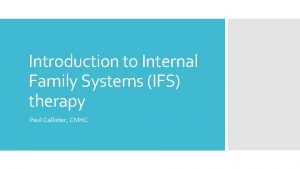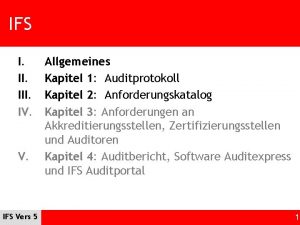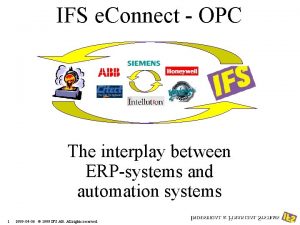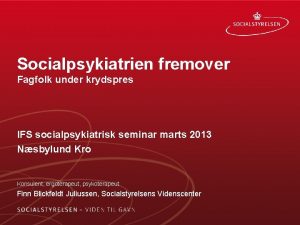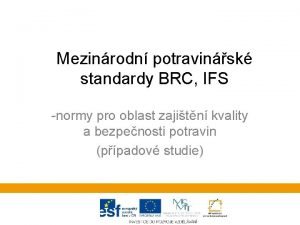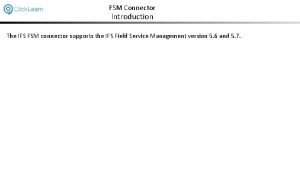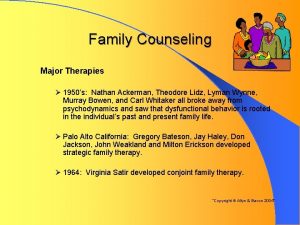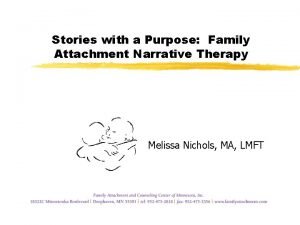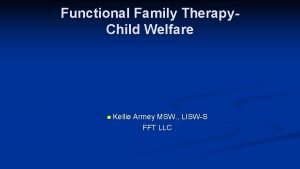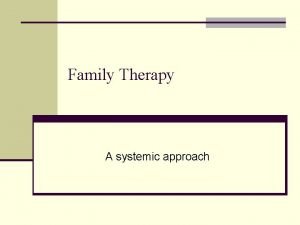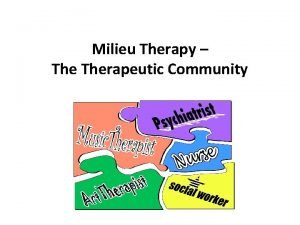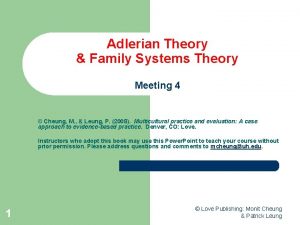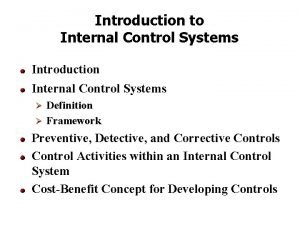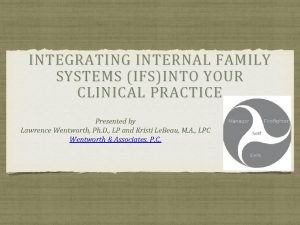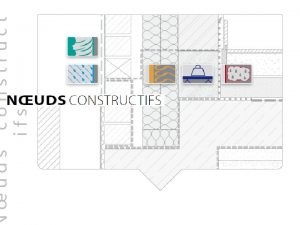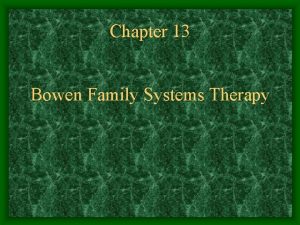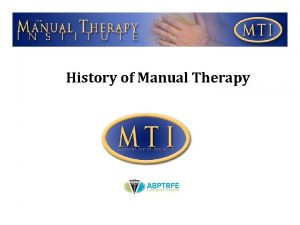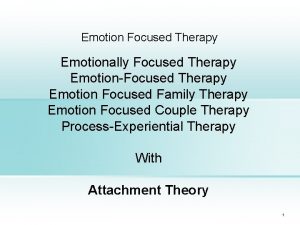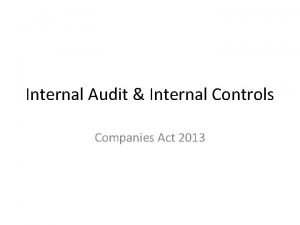Introduction to Internal Family Systems IFS therapy Paul
















































- Slides: 48

Introduction to Internal Family Systems (IFS) therapy Paul Callister, CMHC

Internal Family Systems (IFS) therapy Developed by Richard Schwartz, Ph. D

Internal Family Systems (IFS) therapy How I learned about IFS

Internal Family Systems (IFS) therapy What I like A way to think A way to work

Internal Family Systems (IFS) therapy Resources

Internal Family Systems (IFS) therapy

Internal Family Systems (IFS) therapy

Internal Family Systems (IFS) therapy The Center for Self Leadership selfleadership. org

Internal Family Systems (IFS) therapy History of IFS

Internal Family Systems (IFS) therapy What is it? Principles of family therapy applied to the intrapsychic realm

Internal Family Systems (IFS) therapy Assumption Multiplicity

Internal Family Systems (IFS) therapy Types of Parts (3) Protectors Exiles/hurt parts Self

Internal Family Systems (IFS) therapy Types of protectors (2) Managers Firefighters

Internal Family Systems (IFS) therapy Protects can: Protect the exiles from others Protect the self from pain of exiles

Internal Family Systems (IFS) therapy Characteristics of Self

Eight Cs of self Internal Family Systems (IFS) therapy Compassion Creativity Curiosity Connectedness Courage Confidence Clarity Calm

Five Ps of self Internal Family Systems (IFS) therapy Playfulness Patience Presence Perspective Persistence

Internal Family Systems (IFS) therapy My short list Openness Compassion Curiosity

Internal Family Systems (IFS) therapy The self of client The self of therapist

Internal Family Systems (IFS) therapy Things that are unique to the model Respect for the parts Starting with the protectors Asking for permission The Self

Internal Family Systems (IFS) therapy Principles for working with parts Start with protectors before exiles Permission is needed

Internal Family Systems (IFS) therapy Principles for working with parts Ask client: How do you feel toward the part/feeling? This establishes separation

Internal Family Systems (IFS) therapy Principles for working with parts If positive, have client tell the part how they feel toward it Then, have client listen to the response

Internal Family Systems (IFS) therapy Principles for working with parts If negative, ask client to ask that part to step back Then, ask how client feels toward that part now

Internal Family Systems (IFS) therapy Principles for working with parts If a part won’t step back, work with it

Principles for working with parts Internal Family Systems (IFS) therapy Once client feels neutral or positive toward a part, have client tell the part that is how they are feeling toward the part Have the client listen to the response

Internal Family Systems (IFS) therapy Principles for working with parts Assumption: every part is here for a reason You may not know the reason

Internal Family Systems (IFS) therapy Principles for working with parts Once client feels neutral or positive toward the feeling/part, you can ask it questions

Internal Family Systems (IFS) therapy Principles for working with parts Questions can come from client, to the part or feeling

Internal Family Systems (IFS) therapy Principles for working with parts If you or client do not understand something, you can ask whatever that question is

Principles for working with parts Internal Family Systems (IFS) therapy Watch out for such non-neutral parts: Judgmental parts Over-thinking parts Productive parts Impatient parts

Internal Family Systems (IFS) therapy Principles for working with parts Watch out for such non-neutral parts: Thank those parts and ask them to step back

Internal Family Systems (IFS) therapy Some IFS questions are What is your role/job?

Internal Family Systems (IFS) therapy Some IFS questions are What are you afraid would happen if you stopped doing your role/job?

Internal Family Systems (IFS) therapy Some IFS questions are How old do you think the client is? When did you come around?

Internal Family Systems (IFS) therapy Some IFS questions are How do you feel about your job?

Principles for working with parts Internal Family Systems (IFS) therapy Notice when the client learns something or has an emotion response The client may be asked how they feel toward the part as they learn They can tell the part how they now feel toward it

Internal Family Systems (IFS) therapy Principles for working with parts If we could heal the hurt that is underneath, would you still need to do your job?

Internal Family Systems (IFS) therapy Principles for working with parts If not, is there a role you would prefer to do?

Internal Family Systems (IFS) therapy Principles for working with parts Can you show me the hurt that is underneath?

Internal Family Systems (IFS) therapy Principles for working with exiled parts Witnessing Unburdening

Internal Family Systems (IFS) therapy Comments/ Questions

Internal Family Systems (IFS) therapy Video demonstration with Dr. Schwartz

Internal Family Systems (IFS) therapy What did you notice? Questions?

Internal Family Systems (IFS) therapy Role play Use the video example Client and therapist roles

Internal Family Systems (IFS) therapy Switch

Internal Family Systems (IFS) therapy What did you notice? Questions?

Internal Family Systems (IFS) therapy Paul Callister, CMHC 801 -755 -5138 paul. t. callister@gmail. com
 Judi addelston obituary
Judi addelston obituary Intro to ifs
Intro to ifs Psychoanalytic vs humanistic
Psychoanalytic vs humanistic Bioness integrated therapy system price
Bioness integrated therapy system price Humanistic therapies aim to boost
Humanistic therapies aim to boost Ifsworld com
Ifsworld com Stuart adam ifs
Stuart adam ifs Summeøvelse
Summeøvelse Ifs anforderungskatalog
Ifs anforderungskatalog Valueserp
Valueserp Ifs construction kit
Ifs construction kit Riscv 1b ifs innovation fundfreundforbes
Riscv 1b ifs innovation fundfreundforbes Ifs 7 checkliste excel
Ifs 7 checkliste excel Socialpsykiatrien ballerup
Socialpsykiatrien ballerup Ifs business analyst
Ifs business analyst Qnx dumper
Qnx dumper Brc ifs
Brc ifs Ifs fsm
Ifs fsm Intensity distribution
Intensity distribution Macau institute of financial services
Macau institute of financial services Ifs sachwalterschaft
Ifs sachwalterschaft Jay haley strategic family therapy
Jay haley strategic family therapy Third order cybernetics
Third order cybernetics Models of family therapy ppt
Models of family therapy ppt Medical family therapy
Medical family therapy Ackerman family therapy
Ackerman family therapy Experiential family therapy satir
Experiential family therapy satir Jay haley strategic family therapy
Jay haley strategic family therapy Experiential family therapy
Experiential family therapy Family therapy part 1
Family therapy part 1 Family attachment narrative therapy
Family attachment narrative therapy Functional family therapy nyc
Functional family therapy nyc Family therapy daft
Family therapy daft Family therapy daft
Family therapy daft Poetry therapy exercises
Poetry therapy exercises Limitations of functional family therapy
Limitations of functional family therapy Systemic family therapy techniques
Systemic family therapy techniques Alicia reign family therapy
Alicia reign family therapy Apply for graduation usu
Apply for graduation usu Internal control introduction
Internal control introduction Internal control and internal check
Internal control and internal check Therapeutic community and milieu therapy
Therapeutic community and milieu therapy Module 70 introduction to therapy
Module 70 introduction to therapy Conclusion on topic family
Conclusion on topic family Periodic table families
Periodic table families Binuclear family vs blended family
Binuclear family vs blended family Family systems theory social work
Family systems theory social work Family systems theory powerpoint
Family systems theory powerpoint Introduction of internal control
Introduction of internal control

